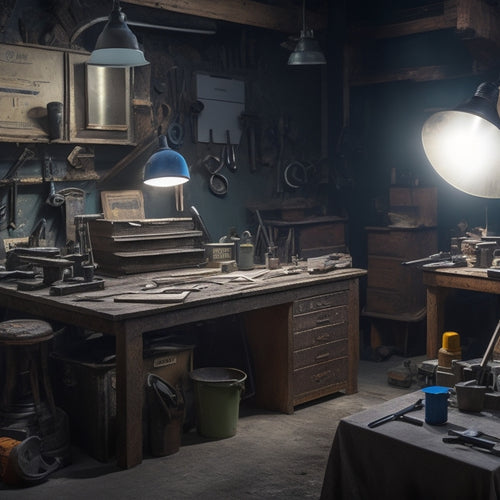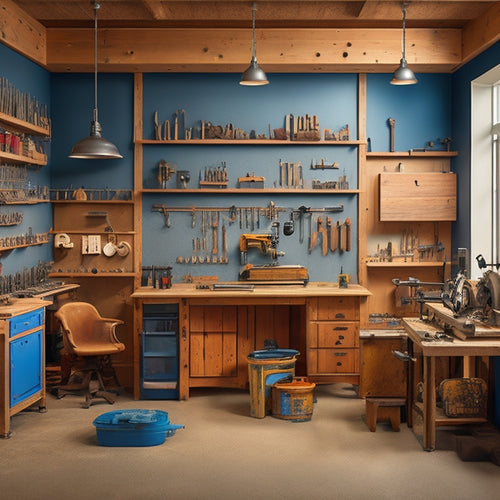
Top Tools for Garden Renovation on a Budget
Share
With a little creativity and resourcefulness, you can renovate your garden on a budget. Start with the essentials: a sturdy trowel, reliable pruning shears, garden rake, and watering can or hose with adjustable nozzles. Get DIY-savvy and repurpose household items like old forks, tin cans, and egg cartons as makeshift gardening tools. Next, focus on affordable soil preparation options like compost, manure tea, and fish emulsion. Don't forget budget-friendly landscaping essentials like native plants, repurposed materials, and cohesive color schemes. And, if you're ready to take your garden to the next level, you'll find even more innovative solutions and expert tips waiting to be uncovered.
Key Takeaways
• Invest in basic tools like sturdy trowels, pruning shears, and garden rakes to get started with garden renovation on a budget.
• Utilize DIY gardening tool alternatives like old forks, tin cans, and egg cartons to reduce costs and promote creativity.
• Focus on affordable soil preparation and fertilization methods like composting, manure tea, and fish emulsion for sustainable gardening.
• Implement budget-friendly landscaping and design techniques, including using native plants, repurposed materials, and cohesive color schemes.
• Opt for inexpensive irrigation solutions like DIY drip irrigation systems, micro-irrigation, and rainwater harvesting to conserve water and resources.
Essential Gardening Tools on Budget
When revamping your garden on a shoestring, investing in the right tools is crucial, and starting with the essentials will help you get the most bang for your buck.
You'll want to prioritize tools that'll support your budget planting strategies and cost-effective garden maintenance. Begin with a sturdy, reliable trowel for planting and transplanting. A good pair of pruning shears will help you maintain shape and promote healthy growth. Don't underestimate the importance of a trusty garden rake for efficient soil preparation and debris removal.
Next, consider a watering can or hose with adjustable nozzles to conserve water and target specific areas. A garden cart or wheelbarrow will make transporting plants, soil, and other materials a breeze.
Finally, invest in a set of measuring tapes and gardening gloves to protect your hands and guarantee accurate plant spacing. By focusing on these must-haves, you'll be well-equipped to tackle your garden renovation without breaking the bank.
Affordable Soil Preparation Options
With a few simple tweaks to your soil preparation routine, you can create a fertile foundation for your garden without draining your wallet. Affordable soil preparation options are within reach, and we're about to dig in.
Soil amendments are key to revealing your garden's potential. Instead of breaking the bank on expensive fertilizers, consider these budget-friendly alternatives:
| Budget Fertilizer | Benefits |
|---|---|
| Compost | Rich in nutrients, improves soil structure |
| Manure Tea | Natural, slow-release fertilizer |
| Fish Emulsion | High in phosphorus, promotes root growth |
These budget fertilizers not only save you money but also provide a more sustainable approach to gardening. Compost, for instance, reduces waste and creates a nutrient-dense soil amendment. Manure tea, on the other hand, is a natural, slow-release fertilizer that promotes beneficial microbes. Fish emulsion, rich in phosphorus, stimulates root growth and healthy plant development.
Budget-Friendly Landscaping Essentials
To transform your outdoor space without overspending, you'll need to prioritize budget-friendly landscaping essentials that deliver maximum impact without breaking the bank.
Start by selecting native plants that thrive in your local climate, reducing the need for expensive fertilizers and pesticides. Not only will native plants save you money, but they'll also attract local pollinators and add unique character to your garden.
Consider visiting community gardens in your area to get inspiration and advice from experienced gardeners. You can also repurpose materials like rocks, logs, and broken pottery to create visually appealing garden features.
Another cost-effective strategy is to focus on creating a cohesive color scheme using plants with similar hues, rather than relying on expensive hardscaping.
By incorporating these budget-friendly landscaping essentials, you'll be able to create a stunning outdoor space that reflects your personal style without draining your wallet.
With a little creativity and resourcefulness, you can achieve a high-end look on a budget.
DIY Gardening Tool Alternatives
By repurposing items you already own, such as old screwdrivers, pliers, and even household utensils, you can create DIY gardening tool alternatives that get the job done without the hefty price tag. For instance, an old fork can become a makeshift cultivator, while a used tin can transform into a mini greenhouse for your homemade seedling. You can even repurpose containers like egg cartons or toilet paper rolls as biodegradable seed starters. With a little creativity, you can turn almost anything into a functional gardening tool.
When it comes to transplanting, use a repurposed container like a plastic bottle or an old yogurt tub as a mini greenhouse. Simply cut the bottom off, add some potting soil, and plant your seedling. This will provide the necessary protection and warmth for your young plants to thrive.
Cheap yet Effective Pruning Tools
As you tackle your garden renovation on a budget, you're probably wondering which pruning tools will get the job done without breaking the bank.
You'll need to prioritize the hand pruning essentials that'll help you precision-cut and shape your plants.
From choosing the right cutting tool options to selecting the perfect gardening shears, we'll explore the affordable solutions that'll make your pruning tasks a breeze.
Hand Pruning Essentials
You'll grasp the basics of hand pruning with a few essential, budget-friendly tools that'll help you tackle overgrown shrubs and deadhead flowers with confidence.
To begin, you'll need a pair of high-quality bypass pruners, which are ideal for cutting live stems up to ¾ inch in diameter. These pruners use a scissor-like action to make clean cuts, promoting healthy growth and reducing the risk of disease.
Next, add a set of gardening gloves to your arsenal, providing protection from thorns and prickles while also improving grip and control.
When it comes to hand pruning techniques, remember to prune during the dormant season for most plants, making clean cuts just above a growth node.
For seasonal pruning tips, prune spring-flowering shrubs immediately after they finish blooming, and prune summer-flowering shrubs in late winter or early spring.
Cutting Tool Options
With a solid foundation in hand pruning essentials, turn your attention to cutting tool options that won't dent your wallet, including loppers, pruning saws, and hedge shears, which can tackle thicker branches and overgrown shrubs with ease.
These tools are designed to make quick work of stubborn growth, but it's vital to master effective cutting techniques to avoid damaging your plants. For instance, when using loppers, make clean cuts by opening the blades fully and squeezing them shut in one swift motion. Pruning saws require a gentle, back-and-forth motion to prevent tearing the bark. Hedge shears, on the other hand, benefit from a rhythmic, sweeping action to maintain a uniform shape.
To guarantee your cutting tools remain in top condition, prioritize tool maintenance. Regularly clean and lubricate the blades to prevent rust and corrosion. Store them in a dry place, away from direct sunlight, to prolong their lifespan.
Gardening Shear Selection
Selecting the right gardening shears is essential to precision pruning, and when budget is a concern, it's imperative to choose a pair that balances quality with affordability, offering the same level of performance as their high-end counterparts.
You'll find that there are several shear types to evaluate, including bypass, anvil, and ratchet pruners, each designed for specific tasks and plant types. For instance, bypass pruners are ideal for live stems, while anvil pruners are better suited for deadwood. Ratchet pruners provide extra leverage for thicker branches.
When making your selection, don't overlook the importance of ergonomic design. Look for shears with contoured grips, thumb locks, and adjustable tension to reduce fatigue and strain. A well-designed pair of shears will allow you to work efficiently and comfortably, even during extended pruning sessions.
Inexpensive Irrigation System Ideas
By repurposing household items and leveraging micro-irrigation techniques, you can create an effective and inexpensive irrigation system that delivers water directly to your plants' roots.
For instance, you can use an old plastic bottle to create a DIY drip irrigation system. Simply cut the bottle in half, flip it upside down, and use it as a mini-reservoir to supply water to your plants.
You can also use a rain barrel to harvest rainwater and reduce your water bill. Connect the barrel to a drip irrigation system, and you'll be able to deliver water directly to your plants' roots, reducing evaporation and runoff.
Another inexpensive irrigation system idea is to use soaker hoses, which release water slowly and evenly along their length. These hoses are perfect for watering large areas, such as gardens or lawns, and can be connected to a rain barrel or a hose.
Budget Garden Design Software
When designing your garden on a budget, you'll want to utilize software that helps you create a stunning outdoor space without breaking the bank.
With budget garden design software, you can 'design on a dime' and experiment with different layouts, plants, and features without incurring costly mistakes.
Design on a Dime
You'll need a clear visual plan to turn your garden renovation dreams into reality, and budget-friendly garden design software can help you create a professional-looking layout without breaking the bank.
With the right tools, you can experiment with creative garden layouts and achieve a minimalist garden aesthetic without hiring a professional designer.
Here are some essential features to look for in budget garden design software:
-
2D and 3D visualization: Get a realistic view of your design to identify potential issues before you start digging.
-
Drag-and-drop functionality: Easily add plants, paths, and other elements to your design without needing extensive design experience.
-
Plant database and filtering: Browse and select plants based on your climate, soil type, and desired level of maintenance.
Virtual Garden Preview
Previewing your garden design in a virtual environment allows you to visualize the final result, making it easier to identify potential issues and make necessary adjustments before investing time and resources into the renovation.
This is where budget garden design software comes in, providing you with a virtual garden preview. With these tools, you can create a digital twin of your outdoor space, experimenting with different layouts, colors, and textures without breaking the bank.
You can import images of your existing garden or start from scratch, using drag-and-drop functionality to add plants, hardscapes, and other features.
Virtual landscaping software offers a range of features, including 2D and 3D visualization, customizable plant libraries, and even climate-specific recommendations.
By testing different garden design scenarios, you can refine your vision, identify potential problems, and make informed decisions about your renovation.
With a clear plan in place, you'll be able to execute your project with confidence, staying within budget and achieving the outdoor oasis you've always wanted.
Low-Cost Mulching and Composting
As you immerse yourself in your garden renovation, harnessing the power of decomposition can be a game-changer. Creating a low-cost mulching and composting system is an essential step in recycling nutrients and reducing waste.
By adopting effective composting techniques, you'll be able to break down organic matter into a nutrient-rich soil amendment that'll fuel your plants' growth.
Meanwhile, mulch benefits extend beyond mere aesthetics. It helps retain soil moisture, suppress weeds, and regulate soil temperature.
To get started, consider the following low-cost mulching and composting strategies:
-
Repurpose kitchen scraps, leaf litter, and grass clippings into a nutrient-rich compost pile
-
Use cardboard or newspaper to create a weed-suppressing mulch layer
-
Incorporate cover crops into your garden rotation to add organic matter and reduce erosion
Garden Decoration on a Shoestring
Transforming your garden into a stunning oasis doesn't have to break the bank, and with a little creativity, you can create a beautiful and functional space that reflects your personal style on a shoestring budget. With thrifty decor and creative upcycling, you can turn trash into treasure and create unique garden decorations that showcase your personality.
Here are some ideas to get you started:
| Upcycled Material | Garden Decoration |
|---|---|
| Old pallets | Vertical garden planters or outdoor shelving |
| Mason jars | Hanging lanterns or mini greenhouses |
| Broken tiles | Mosaic stepping stones or garden markers |
Get creative with items you already have lying around the house or find at thrift stores. Turn an old bicycle into a planter or a bird feeder, or use old CDs to create a shimmering wind chime. With a little imagination, you can create a beautiful and functional garden on a budget. Remember, the key to garden decoration on a shoestring is to think outside the box and get creative with materials you already have.
Frequently Asked Questions
Can I Use Last Year's Seeds for This Year's Garden?
You're wondering if last year's seeds are still viable for this year's garden. The answer depends on seed viability, which decreases over time.
Check the seeds' packaging for storage instructions and expiration dates. For best germination, store seeds in a cool, dry place.
If you're unsure, perform a germination test: moisten a paper towel, place seeds on it, and wait 7-10 days. If fewer than 50% germinate, it's time to invest in fresh seeds.
How Do I Prevent Pests From Damaging My Garden?
You'll want to deploy a multi-pronged strategy to prevent pests from damaging your garden.
Start by incorporating natural pest control methods, like introducing beneficial insects or using neem oil.
Companion planting is another effective tactic, where you pair plants that repel pests, such as basil with tomatoes or marigolds with carrots.
What Is the Best Time to Renovate My Garden?
You think you're ready to plunge into that garden renovation, but don't rush into it!
Ironically, the best time to renovate your garden is when you're not thinking about it - during the off-season.
Avoid spring planting chaos and focus on renovation during the dormant season.
Consider seasonal factors like soil quality, weather, and pest activity to guarantee a seamless changeover.
Can I Reuse Old Bricks for Garden Pathways?
You're wondering if you can reuse old bricks for garden pathways? Absolutely! With some TLC, those weathered bricks can become a stunning feature.
Start by cleaning them thoroughly to remove dirt and grime.
Then, consider your pathway design - will it be a meandering curve or a straight shot?
Once you've got a plan, lay them out and secure them with sand or mortar.
You'll be amazed at how they add character to your garden.
How Often Should I Water My Plants During Renovation?
Did you know that 70% of plants die from overwatering, not underwatering? When renovating your garden, it's essential to strike the right balance.
You should water your plants when the top 2-3 inches of soil feel dry to the touch. Create a renovation schedule that allows for regular watering sessions, ideally early morning or evening to minimize evaporation.
Avoid watering during peak sun hours to prevent scorching. By doing so, you'll guarantee your plants thrive amidst the renovation chaos.
Conclusion
You've got the tools, the know-how, and the determination to transform your outdoor space on a shoestring. Now, the real fun begins!
As you start digging, planting, and pruning, remember that the most essential element of a successful garden renovation is patience.
Don't be surprised when your budget-friendly endeavors yield more than you bargained for - a thriving oasis that's not only beautiful but also sustainable.
The real magic happens when you least expect it, so stay tuned and get ready to reap what you've sown!
Related Posts
-

Budget-Friendly Materials for Your Home Renovation Project
As you plan your home renovation project, finding budget-friendly materials is key to turning your design vision into...
-

What to Inspect When Buying Used Renovation Tools
When buying used renovation tools, you need to scrutinize every detail to avoid costly mistakes. Inspect for rust and...
-

Renovation Tool Checklist for Smooth Finishes
When tackling a renovation project that requires a smooth finish, you'll need a thorough tool checklist to guarantee ...


